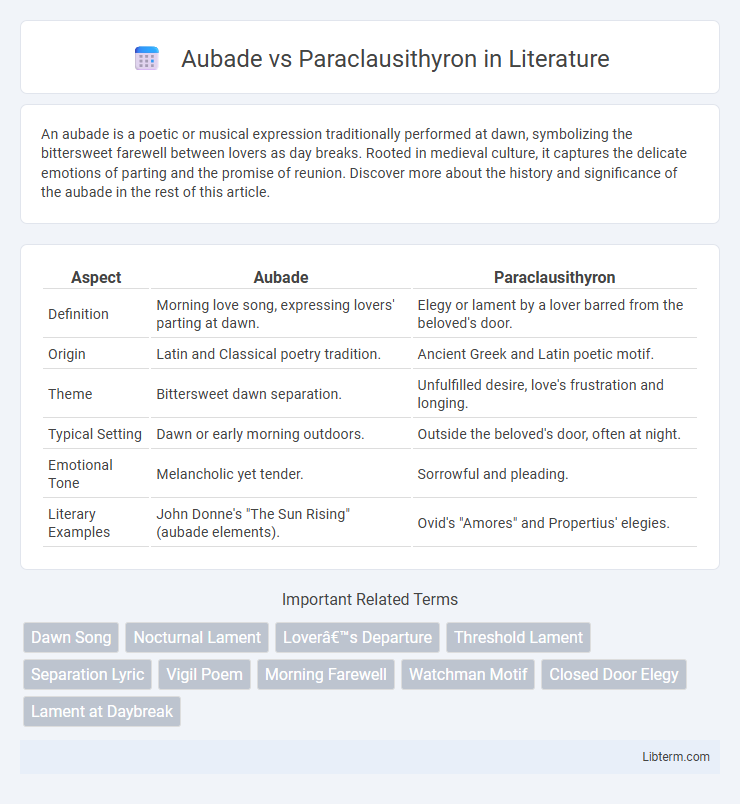An aubade is a poetic or musical expression traditionally performed at dawn, symbolizing the bittersweet farewell between lovers as day breaks. Rooted in medieval culture, it captures the delicate emotions of parting and the promise of reunion. Discover more about the history and significance of the aubade in the rest of this article.
Table of Comparison
| Aspect | Aubade | Paraclausithyron |
|---|---|---|
| Definition | Morning love song, expressing lovers' parting at dawn. | Elegy or lament by a lover barred from the beloved's door. |
| Origin | Latin and Classical poetry tradition. | Ancient Greek and Latin poetic motif. |
| Theme | Bittersweet dawn separation. | Unfulfilled desire, love's frustration and longing. |
| Typical Setting | Dawn or early morning outdoors. | Outside the beloved's door, often at night. |
| Emotional Tone | Melancholic yet tender. | Sorrowful and pleading. |
| Literary Examples | John Donne's "The Sun Rising" (aubade elements). | Ovid's "Amores" and Propertius' elegies. |
Introduction to Aubade and Paraclausithyron
Aubade is a poetic or musical form expressing lovers' farewell at dawn, capturing emotions of parting and longing typical in classical and romantic literature. Paraclausithyron, rooted in Greek and Latin traditions, features a lover lamenting outside a beloved's locked door, symbolizing unrequited love or separation. Both forms explore intimate moments of separation but differ in setting and emotional nuance, with Aubade emphasizing dawn's parting and Paraclausithyron focusing on the barrier of a closed door.
Defining the Aubade: Origins and Themes
The aubade is a poetic or musical form traditionally centered on lovers parting at dawn, originating from medieval troubadour culture and later embraced by French Renaissance poetry. It explores themes of love, separation, and the bittersweet emotions associated with daylight breaking the night. Unlike the paraclausithyron, which focuses on a lover lamenting outside a locked door, the aubade emphasizes the transition from night's intimacy to daytime reality.
Paraclausithyron: Meaning and Historical Context
Paraclausithyron is a classical poetic motif originating in ancient Greek and Roman literature, centered on a lover lamenting outside the closed door of their beloved, symbolizing unfulfilled desire and separation. This trope often appears in elegiac poetry and Roman love elegies by authors like Propertius and Ovid, reflecting social and emotional themes of longing and exclusion. Paraclausithyron contrasts with the Aubade, which typically celebrates dawn and lovers parting, emphasizing the theme of physical and emotional barriers in romantic expression.
Structural Differences between Aubade and Paraclausithyron
Aubade is a morning love song typically structured with alternating stanzas depicting lovers parting at dawn, emphasizing light and awakening imagery. Paraclausithyron centers around the lament of a lover locked out, often featuring repetitive motifs of door-knocking and separation, with a focus on emotional intensity and confinement. Structural differences lie in Aubade's balanced, lyrical format celebrating dawn's arrival, while Paraclausithyron employs a more narrative, plea-driven structure highlighting physical barriers and longing.
Key Motifs in Aubade Poetry
Aubade poetry centers on the key motifs of dawn, separation, and the bittersweet nature of parting lovers as morning light forces them apart. Themes of vulnerability and longing highlight the emotional tension between night's intimacy and day's inevitable arrival. The motif of awakening symbolizes both physical morning and the painful awareness of loss, contrasting with the Paraclausithyron's focus on blocked love and night-time lament.
The Lament of the Lover: Paraclausithyron’s Central Focus
Paraclausithyron centers on the lover's lament of being shut out from the beloved, expressing intense longing and emotional turmoil caused by physical separation. This genre uses vivid imagery to depict barriers and obstacles, often emphasizing the pain and frustration of unfulfilled desire. Unlike the aubade, which celebrates the bittersweet parting at dawn, paraclausithyron maintains a tone of despair and pleading, highlighting the lover's sorrow and isolation.
Notable Examples from Classical Literature
Aubades like in Catullus 5 celebrate lovers greeting the dawn, symbolizing intimacy and renewal. Paraclausithyron is exemplified by Propertius 2.1, where the poet laments separation outside his lover's locked door, embodying longing and frustration. These contrasting motifs illustrate classical explorations of love's joy and despair in Latin elegy.
Influence on Later Literary Traditions
Aubades, characterized by their morning love songs, influenced courtly love poetry and the development of pastoral and romantic motifs in Renaissance literature, inspiring poets like Shakespeare and John Donne. Paraclausithyron, involving lamentation at a closed door, shaped themes of unfulfilled love and separation, resonating through medieval lyric poetry and influencing troubadour and Minnesinger traditions. The interplay of aubade and paraclausithyron enriched narrative techniques and emotional expression in Western literary canons.
Modern Adaptations and Interpretations
Modern adaptations of Aubade often emphasize intimate morning dialogues reflecting contemporary themes of love and vulnerability, blending traditional poetic forms with experimental language to capture transient emotional states. Paraclausithyron is reinterpreted in modern literature and theater as a motif of longing and separation, often symbolizing emotional barriers and unrequited desire through innovative narrative structures and multimedia performances. Both forms find resonance in digital poetry and performance art, where their classical conventions are deconstructed to explore the complexities of modern relationships and individual isolation.
Conclusion: Comparing Aubade and Paraclausithyron
Aubade and Paraclausithyron both explore themes of separation and longing at dawn, yet Aubade emphasizes the bittersweet beauty of morning partings while Paraclausithyron centers on the intense emotional anguish of being locked out from a lover's presence. Aubades often express a gentle, hopeful tone with the promise of reunion, whereas Paraclausithyron conveys frustration and despair through vivid imagery of confinement. The contrast highlights diverse emotional landscapes in classical poetry's depiction of love and absence.
Aubade Infographic

 libterm.com
libterm.com